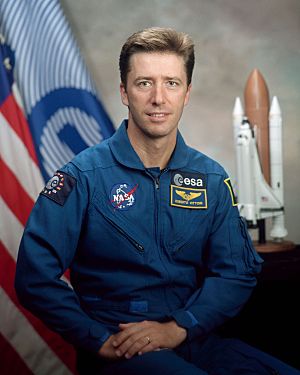Roberto Vittori facts for kids
Quick facts for kids
Roberto Vittori
OMRI |
|
|---|---|
 |
|
| Born | 15 October 1964 |
| Status | Retired |
| Nationality | Italian |
| Occupation | Test Pilot |
| Space career | |
| ASI/ESA astronaut | |
| Rank | |
|
Time in space
|
35d 12h 26m |
| Selection | 1998 ESA Group |
| Missions | Soyuz TM-34/TM-33, Soyuz TMA-6/TMA-5, STS-134 |
|
Mission insignia
|
|
Roberto Vittori is a brave Italian Air Force officer and an ESA astronaut. He was born on October 15, 1964, in Viterbo, Italy. After finishing his studies at the Italian Air Force Academy, Vittori became a pilot. He later trained to be a test pilot in the United States.
In 1998, the ESA chose Vittori to join their team of astronauts. He has flown to space three times! His missions included two trips to the International Space Station (ISS) on Russian Soyuz spacecraft. He also flew on the STS-134 mission, which was one of the very last flights of the American Space Shuttle Program in 2011. He was the last astronaut from outside the U.S. to fly on the Space Shuttle.
Contents
Roberto Vittori's Journey to Space
Early Career and Flight Training
Roberto Vittori graduated from the Italian Air Force Academy in 1989. He then went to the United States for more training. He flew the Panavia Tornado aircraft for the Italian Air Force. In 1995, he graduated from the United States Naval Test Pilot School. He was the top student in his class!
After that, he worked at the Italian Test Center. He helped develop a new European aircraft called the EF2000. Vittori flew Tornado GR1 planes from 1991 to 1994. During this time, he learned how to refuel planes in the air, both day and night. He also became a leader for formation flights.
Roberto Vittori has flown over 1,700 hours in more than 40 different types of aircraft. These include planes like the F-104, F-18, and G-222.
Becoming an Astronaut
In August 1998, the European Space Agency (ESA) picked Roberto Vittori to join the European Astronaut Corps. He moved to the Johnson Space Center in Houston, Texas. After lots of training, Vittori worked on many technical projects for NASA's Astronaut Office.
First Space Mission: Soyuz TM-34
From April 25 to May 5, 2002, Vittori went on his first space mission. This was the Soyuz TM-34 flight to the International Space Station (ISS). This mission was a team effort between Russia, the Italian Space Agency (ASI), and the ESA.
While on the ISS, Vittori worked with the crew already living there. He helped with four European science experiments. The mission also brought a new "lifeboat" to the Station. This lifeboat is a special spacecraft for astronauts to use if there's an emergency. Vittori returned to Earth on the Soyuz TM-33 spacecraft.
Second Space Mission: Soyuz TMA-6
On April 15, 2005, Roberto Vittori flew to the International Space Station (ISS) again. This was his second trip, on the Soyuz TMA-6 mission. He came back to Earth on April 24 in the Soyuz TMA-5 capsule. He was the first European astronaut to visit the ISS twice!
During this mission, he did experiments on how astronauts' arm muscles get tired. He also studied how plant seeds grow in space. This research could help astronauts grow their own food in the future.
Art in Space
On this mission, Vittori also took a special painting into space. It was by an artist named George Pusenkoff, called Single Mona Lisa (1:1). Vittori took photos of the painting on the International Space Station. This was part of a project called "Mona Lisa Travels." It showed how art and science can connect, just like they did in the life of Leonardo da Vinci, who painted the original Mona Lisa. The painting was carefully rolled up to fit on the spacecraft. On April 25, 2005, Vittori brought the painting back to Earth.
Third Space Mission: STS-134
In 2011, Vittori was a mission specialist on NASA's Space Shuttle mission STS-134. This was a very important flight because it was one of the last missions for the Space Shuttle. Roberto Vittori was the last astronaut from a country other than the U.S. to fly on the Space Shuttle.
Personal Life
Roberto Vittori has three sons.
Gallery
-
Vittori (right) with fellow ESA astronaut Paolo Nespoli aboard the ISS.
See also
 In Spanish: Roberto Vittori para niños
In Spanish: Roberto Vittori para niños




